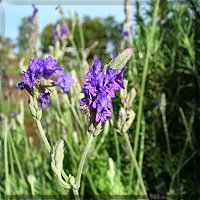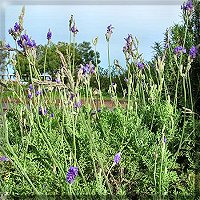

Lavandula officinalis


Lavandula officinalis
Other Names - L. officinale. L. spica. pro parte. L. vera. (not of gardens); Lavandula vera; Lavandula spica; Lavandula officinalis; L. delphinensis; L. fragrans; L. latifolia
Description - True lavender (Lavandula officinalis) occurs as a small, sparsely branched wild plant in the north Mediterranean from Spain to Greece, where it grows wild or cultivated at medium altitudes (600 - 1500m) of mountain regions. It is cultivated as a garden ornamental in much of Europe. Smaller cultivations exist in Australia, England, Yugoslavia and Russia. However as sufficient concentration of essential oil is only produced in suitably hot dry climates, the bulk of production takes place in south east France where it is grown on a field scale usually at 700 - 1200 m altitude. True lavender is an evergreen sub-shrub with much branched woody stems forming a dense hemispherical clump. All parts of the plant have the characteristic scent of lavender. Woody stems are 20 - 30cm long and densely covered in opposite, small, green, entire, linear leaves. Flowering stems are leafless and unbranched and rise well above the leafy stems up to 60cm in height. Flowers are small, bluish and 2-lipped and are easily separated from the spike-like terminal panicles. This herb has been used extensively in perfumes, soaps, and sachets. Originally, the oil from the flower was used to protect cloths and stored linens from moths. It was, and is, used as a scent in air fresheners.
Pharmacology - The typical constituents of lavender oil are Linalool 29 - 46%, Linalyl Acetate 36 - 51%, 1.8-Cineol 0.1 - 2.2%, Caryophyllene 2.5 - 7.6%, Terpinen-4-ol 2.7 - 6.9%, Ocimenes 2.5 - 10.8%, Lavandulyl Acetate 3.4 - 6.2%, (Aqua Oleum, 1993). The content of linalyl acetate increases with altitude at which the plants are grown.
Medicinal Uses - The herb exhibits activity against diphtheria, typhoid, pneumonia, staph, strep and many flu viruses. Lavender is also useful as an antibacterial agent. Known topical uses include acne, burns, cellulite, cold sores, eczema, edema, fatigue, halitosis, headache, infection, insect bites, insect repellent, insect stings, irritability, joint pain, lice, muscle soreness, rheumatism, scabies, scars, snakebites, toothache, vertigo, and yeast infections. Traditionally, herbalists used Lavender for a variety of conditions of the nervous system, including depression and fatigue. It has also been used for headache and rheumatism. In Arab medicine, it was used as an expectorant and an antispasmodic. Lavender water, made from the essential oil, is used in therapeutic baths to reduce nervous excitement. The oil has a sedative action on the heart and will lower blood pressure. A small amount added to bland oils makes a useful application in skin diseases, such as eczema and psoriasis, and a rub for rheumatic conditions. Oil distilled from the flower has applications as a stimulant, tonic, headache relief, and for relief of intestinal gas. It is also used to quiet coughs and disinfect wounds. Applied as a compress, lavender oil provides relief from neuralgic pains, rheumatism, sprains, and sore joints.